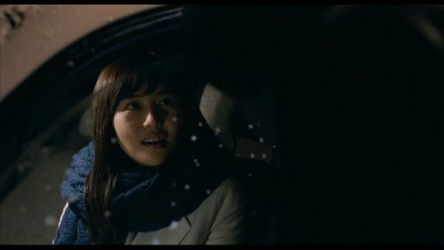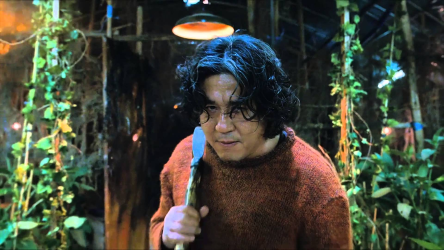Korean revenge pictures, I warned The Flower, are not like American ones. They are not meant to be cathartic action films where you identify strongly with an aggrieved protagonist who is righting a wrong. After seeing I Saw The Devil, she said “I was listening to The Boy [enthuse about it] and agreeing with him, but I found the movie very upsetting.” American revenge pictures, she observed, were about justice. The hero constantly has to ask himself, “Have I gone too far? Am I becoming what I hate?” And the answer is usually “No,” because we want films where vigilantes pick up where the system fails, and all is well afterwards.
Even for a Korean revenge thriller, I Saw The Devil is extreme. A woman is brutally murdered by a serial killer, and her fiancee determines to avenge her death—by taking two weeks off from work to hunt down the culprit. (The “two weeks” thing is the first sign that something is not as it appears. He seems remarkably self-assured that he’s going to be able to do this and not need any extra time.) He starts with four suspects, whom he detains and tortures with a cold efficiency. Determining they are not the one he is looking for, he moves on to suspect #3. The killer, realizing he is caught, takes another victim—a school girl—and figures he may as well rape her (given his cover as a school bus driver is blown).

Women fare poorly in this film.
Our protagonist Soo-hyeon catches up to our killer, Kyung-chul at this point and proceeds to beat the tar out of him. While this is disturbing, it’s probably more disturbing that Soo-heyon seems completely indifferent to the rape victim. He doesn’t rush to stop the crime. He offers no comfort. His sole focus is on beating up Kyung-chul—and shoving a transmitter down his throat and a bunch of money in his pocket. The transmitter is a super-spy gadget that gives Soo-hyeon the killer’s location and actually also works as an eavesdropping device.
We are getting the idea that Soo-hyeon has a “particular set of skills”.
In almost John Wick-ian fashion, Kyng-chul flags down a cab which turns out to have just been stolen by the two guys pretending to be the driver and passenger, with the real driver dead in the trunk. The ensuing accident, to say nothing of Kyung-chul’s earlier beating at the hands of Soo-hyeon, leads him to a small town clinic where, after receiving treatment, he goes to rape the nurse.

Kyung-chul before Soo-hyeon gets a hold of him.
Once again, Soo-hyeon catches up to him (leisurely indifferent to Kyung-chul’s latest victim) and begins beating the tar out of him again, this time including severing one of his Achilles’ tendons. Soo-hyeon’s plan is to track and torment the killer (for the next two weeks, presumably) to deliver an equivalent amount of suffering to him that Kyung-chul delivered to his fiancee and himself.
Kyung-chul’s next stop is a fancy house where two of his friends—also psychotic killers who may have been hoping to form a (John Wick-style!) league of super-psychotics that just “f*cked up the world”, as the subtitles put up. These latest pals are, on top of everything, cannibals, keeping a victim in house for the freshest cuts. Once again, our “hero” rather indifferently barges in, but now it’s three psychos against one.
As he must (at least in Korean movies, and in the American Death Warrant), Soo-hyeon overplays his hand and ends up losing control of the psychotic Kyung-chul, whose master plan is to kill everyone he can find that Soo-hyeon loves—and then turn himself in. (Amusingly, Kyung-chul realizes early on that it’s not the cops after him because Korean officials, police or otherwise, are basically incompetent. The #1 trope of Korean films.) Soo-hyeon is also getting pressure from his peers and superiors who have realized that he’s behind the violence.

Kyung-chul AFTER Soo-hyeon gets a hold of him. The first time.
In the end, the final revenge is darker than dark, and our hero is left broken for having achieved it. Because Revenge Is Bad.
Great performances by Byung-hun Lee (who plays the lovable but thuggish boxer in Keys to the Heart and, uh, the Asian dude in the recent The Magnificent Seven) as Soo-hyeon, and Min-sik Choi (who gave a tremendous performance in A Heart Blackened but is probably most famous for the most famous Korean revenge picture, Oldboy) as Kyung-chul. At two hours and twenty minutes, you feel every cringing moment of this tense, suspenseful film, and The Boy praised its Hitchcockian technique, comparing it favorably with Frenzy. The Flower, as noted, did not disagree—but found the film upsetting and probably won’t be viewing any Korean revenge pictures in the future.
Which is fine.
I agree with both of them: It is a very well-crafted, tight and upsetting film. Recommended for those with strong stomachs. Post-viewing question: Who is it who saw the Devil, and who was the Devil? (And that is the original Korean title!)

A girl about to do something that almost works.
